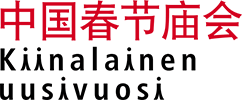Traditional Chinese instruments
There is a bunch of Chinese musicians in the Chinese new year festival that are performing soloist acts with traditional Chinese instruments. In China during the 1900s modernization movement musicians moved to use western equal temperament system. Then the traditional Chinese instruments were changed so that they could be used to play the twelve equal tones on a logarithmic scale that is required in the equal temperament system. Before this, there were different temperament systems used in different parts of China and instruments were formed by the systems. In some forms of Chinese music, there are still some practices used that differ from the equal temperament system. For example, in Beijing-opera some scale steps differ from western scales.
Often heard in the Chinese new year festival is a Chinese violin, erhu (二胡, èrhú) that belongs to the spike fiddle instrument class. Erhu has two strings and a musical bow in the middle. The bow can’t be taken off the instrument unless one of the strings is also taken off. The violins resonator body is covered with python skin and it is played by resting on the performers left thigh.
Another classic Chinese instrument is guzheng (古箏, gǔzhēng), which is a zither instrument. It reminds a lot of Finnish zithers as they both are similar finger plucked instruments. Playing Guzheng requires skill and finger dexterity, it’s typical that players use “fake nails” on their fingers that help them play better. Guzheng is familiar for many as its popularity and beautiful melodies have guaranteed its place in the center of Chinese folk music.
Known better as a Chinese lute the pear-shaped pipa (琵琶, pípá), is one of the most important instruments in Chinese music. It’s a four-stringed plucked instrument that is held by a sitting player in a vertical position. Bamboo flute is a very typical original Chinese instrument. Bamboo flute differs from the western flutes because of an additional hole between the embouchure and finger-holes. It’s covered with a thin membrane that gives the instrument the typical rough shivering tone. Chinese mouth-blown organ (笙, shēng) is an old instrument that is broadly spread in Asia. It’s one of the rare polyphonic instruments. Sheng is seen as a prototype of accordion and mouth organ. Sheng is a common instrument of solo- and traditional Chinese bands.
Chinese hammered dulcimer, Yángqín (扬琴), is a string instrument that is played by striking with rubber-tipped sticks. The instruments strings are stretched over a trapezoidal soundboard. Yangqin has been called a Chinese piano because it has been used a lot to accompany Chinese string- and wind instruments.
Different kind of drums are also part of traditional Chinese instruments. Traditional Chinese music isn’t rhythmically as complicated as for example traditional Indian music but it resembles more traditional music of Korea and Japan.
